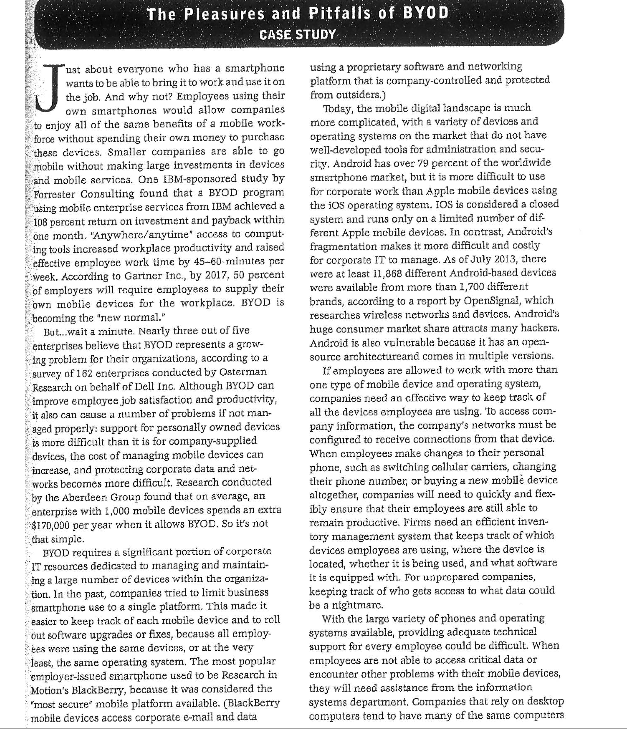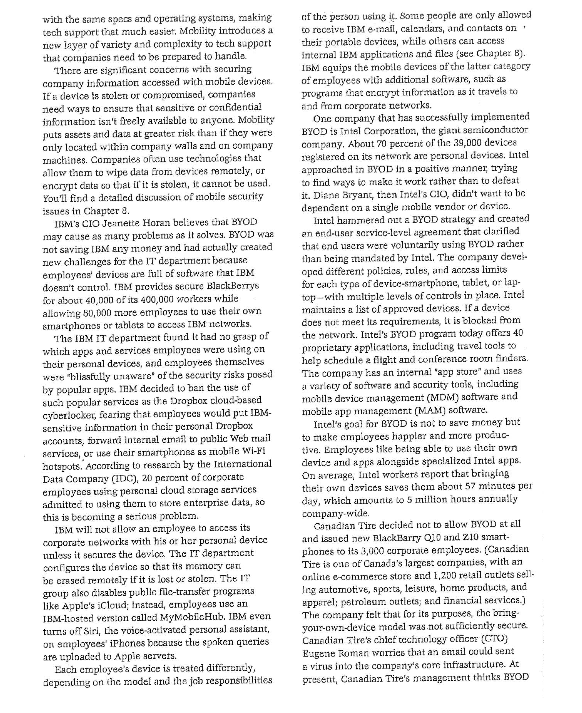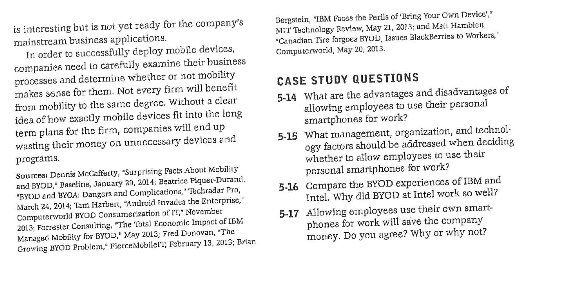Task:
Executive summary
The Pleasures and Pitfalls of BYOD CASE STUDY ist about everyone who has a smartphone using a proprietary software and networking wants to be able to bring it to work and use it on platform that is company-controlled and protected the job. And why not? Employees using their from outsiders. ) own smartphones would allow companies Today, the mobile digital landscape is much to enjoy all of the same benefits of a mobile work- more complicated, with a variety of devices and force without spending their own money to purchase operating systems on the market that do not have "these devices. Smaller companies are able to go well-developed tools for administration and secu- "mobile without making large investments in devices rity. Android has over 79 percent of the worldwide and mobile services. Ons EBM-sponsored study by smentphone market, but it is more difficult to use Forrester Consulting found that s BYOD program for corporate work than Apple mobile devices using using mobile enterprise services from IBM achieved a the 105 operating system. IOS is considered a closed 108 percent return on investment and payback within system and runs only on & limited number of dif- one month. "Anywhere/ anytime' access to comput- ferent Apple mobile devices, In contrast, Android's ing tools increased workplace productivity and raised fragmentation makes it more difficult and costly effective employee work time by 45-60 minutes per Aweek. According to Gartner Inc., by 2017, 50 percent for corporate IT to manage. As of July 2013, there were at least 11,868 different Android-hased devices of employers will require employers to supply their were available from more than 1,700 different own mobile devices for the workplace. BYOD is brands, according to a report by OpenSignal, which becoming the "new normal." researches wireless networks and devices, Android's But. .wait a minute. Nearly three out of five huge consumer market share attracts many hackers. enterprises believe that BYOD represents a grow- Android is also vulnerable because it has an open- ing problem for their organizations, according to a source architectureand comes in multiple versions. survey of 162 enterprises conducted by Osterman If' employees are allowed to work with more than Research on behalf of Dell Inc. Although BYOD can one type of mobile device and operating system, improve employee job satisfaction and productivity, companies need an effective way to keep track of it also can cause a number of problems if not man- all the devices employees are using. To access com- aged properly: support for personally owned devices pany information, the company's networks must be is more difficult than it is for company-supplied configured to receive connections from that device. devices, the cost of managing mobile devices can When cmployees make changes to their personal increase, and protecting corporate date and net- phone, such as switching callular carriers, changing works becomes more difficult. Research conducted their phone number or buying a new mobile device by the Aberdeen Group found that on average, an altogether, companies will need to quickly and flex- enterprise with 1,000 mobile devices spends an extra ibly ensure that their employees are still able to *$170,000 per year when it allows BYOD. So it's not remain productive. Firms need an efficient inven- that simple. tory management system that keeps track of which BYOD requires a significant portion of corporate devices employees are using, where the device is IT resources dedicated to managing and maintains- located, whether it is being used, and what software ing a large number of devices within the organiza- it is equipped with. For unpropared companies, Gaon. In the past, companies tried to limit business keeping track of who gets access to what data could smartphone use to a single platform. This made it be a nightmare. easier to keep track of each mobile device and to roll With the large variety of phones and operating out software upgrades or fixes, because all employ- systems available, providing adequate technical ees wom mising the same devions, or at the very least, the same operating system. The most popular support for every employee could be difficult. When employees are not able to access critical data or employer-issued smartphone used to be Research in encounter other problems with their mobile devices, Motion's BlackBerry, because it was considered the they will need assistance from the information "most secure" mobile platform available. (BlackBerry mobile devices access corporate e-mail and data systems department, Companies that rely on desktop computers tend to have many of the same computerswith the same spams and operating systems, making of the person using it Some people are only allowed tech support that much easier, Mobility introduces a co receive IBM e-mail, calendars, and contacts on new layer of variety and complexity to tech support their portable devices, while others can access that companies need to be prepared to handle internal IBM applications and files {see Chapter B). There are significant concerns with securing IBM equips the mobile devices of the latter catagory company information accessed wich mobile devices. of employees with additional software, such as If's device to stolen or compromised, companies programs that encrypt information as it travels to need ways to ensure that sensitive or confidential and from corporate networks. information isn't freely available to anyone Mobility One company that has successfully implemented puts assets and data at greater risk than if they were BYOD is Intel Corporation, the giant semiconductor only located within company walls and on company company. About 70 percent of the 39,000 devices machines. Companies often use technologies that registered on its network are personal devices. Intel allow them to wipe data from devices mmotely, or approached in BYOD in a positive manner trying encrypt date so that il it is stolen, it cannot be used. You'll find a detailed discussion of mobile security on find ways to make it work rather than to defeat it. Diana Bryant, then Intel's CIO, didn't want to be issues in Chapter 2. dependent on a single mobile vendor or device IBM's CIO Jeanette Horan believes that BYOD Intel hammered out & BYOD strategy and created may cause as many problems as It solves. BYOD was an end-user service-level agreement that clarified not saving IBM any money and had actually created that end users were voluntarily using BYOD rather new challenges for the IT department because than being mandated by Intel. The company devel- employers' devices are full of suftware that IBM oped different policies, rules, and access limits doesn't control. !EM provides secure Black Berry's for each type of device-smartphone, tablet, or lap- for about 40,000 of its 400,000 workers while top-with multiple levels of controls in place. Intel allowing 50,000 more employees to use their own maintains a list of approved devices. If a device smartphones or tablets to access IBM networks. does nut meet its requirements, it is blocked from The IBM IT department found It had no grasp of the network. Intel's BYQD program today offery 40 which apps and services employees were using on proprietary applications, including travel tools to their personal devices, and employees themselves help schedule a flight and conference room finders. were "blissfully unaware" of the security risks posed The company has an internal 'app store" and uses by popular apps. IBM decided to ban the use of I variety of software and accurity tools, including such popular services as the Dropbox cloud-based mobile device management (MDM) software and cyberlocker, fearing that employees would put IBM- mobile app management (MAM) software. sensitive information in their personal Dropbox Intel's goal for BYOD is not to save money but accounts, forward internal email to public Web mail to make employees happler and more produc- services, or use their smartphones as mobile WI-FI tive. Employees like being able to use their own hotspots. According to research by the International device and apps alongside spanlalized Intel apps. Data Company (100), 20 percent of corporate On average, Intel workers report that bringing employees using personal cloud storage services their own devices saves them about 57 minutes per admitted to using them to store enterprise data, so day, which amounts to 5 million hours annually this is becoming a serious problem. company wide. IBM will not allow an employee to access its Canadian Tire decided not to allow DYOD at Ell corporate networks with his or her personal device and issued new BlackBarry Q10 and 210 smart- unless it senures the devlos The IT department phones to its 3,900 corporate employees. (Canadian conf gures the device so that its momory cuni Tire is our of Canada's largest companies, with an be crazed remotely if it is lost or stolon. The I'm online e-commerce store and 1,200 retail outlets sell- group also alsables public file-transter programs Ing automotive, sports, leisure, home products, and like Apple's iCloud; Instead, employees use an upperel; patrolaum outlets; and financial services.) I BM-hosted version called MyMobicHub, IBM even The company felt that for its purposes, the bring- turns off Siri, the voice activated personal assistant, your-own-device model was not sufficiently secure. on employees' iPhones because the spoken queries Canadian Tire's chief technology officer (CTO) are uploaded to Apple acrects. Eugene Roman worries that an email could sent Each employee's device is treated differently, a virus into the company's com infrastructure. At depending on the model and the job responsibilities present, Canadian Tire's management thinks BYODis interesting but is not yet ready for the company's Derpainin, "TBMt Faces the Perils of 'Bring Your Own Device'," mainstream business applications. MiT Technology Revlaw, May 21, 2015; und MAUL Herablon In order to successfully deploy mobile devloss, "Canadian Tire fargoes BYUD, James BlackBerries to Workers," companies need in carefully examine their business Computerwarid, May 20, 2013. processes and determine whether or not mobility makes sense for them. Not every firm will benefit CASE STUDY QUESTIONS from mobility to the same degree. Without a clear 5-14 What are the advantages and disadvantages of idea of how exactly mobile devices fit into the long allowing employees to use their personal term plans for the firm, companies will end up smartphones for work? wasting their money on unnecessary devlocy and 5-16 What management, organization, and technol programs. ogy factors should be addressed when deciding Sourceal Dennys McCafferty, "Surprising Facts About Mebilly whether to allow employees in use their and BYDD," Daselicia, January 20, 2014; Beatrice Piquer-Purnil. personal smartphones for work? "FYDD end 1704: Dangers and Complications, " Techradar Pro, 5-16 Compare the BYOD experiences of IBM and March 24, 2014; Thi Herbert, "Android Invades the Enterprise," Intel. Why did BYOD at Intel work so well? Computerworld HYOD Consumer zation of'I'S" November 2013 Farrenier Consulting, The Total Fronomic Impact of IBM 5-17 Allowing employees use their own smart- Meraged Mebatty for BYDD,' May 2015; Fred Donovan, "The phones for work will save the company Growing BYQD Problem,* MereMobilet's Petruary 13, 2013; Malar money. Do you agree? Why or why not









